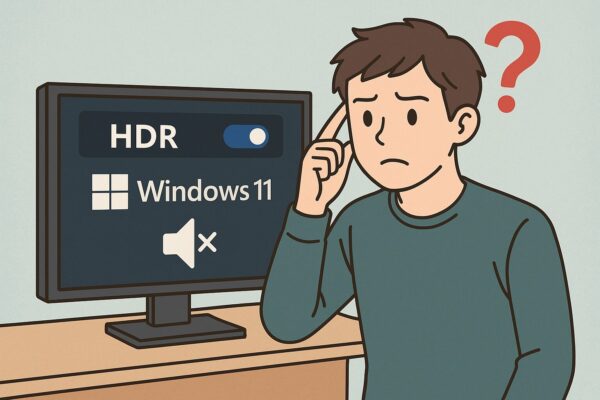
Some Windows 11 users have recently encountered a puzzling issue: the moment they enable HDR, their system suddenly stops outputting sound. If you’re experiencing this strange behavior, you’re not alone. Since the June 2025 Windows Update (notably KB5060533), a growing number of users have encountered this audio bug—specifically when HDR is turned on. In this article, we’ll walk you through the symptoms, causes, and step-by-step solutions to get your sound working again, even with HDR enabled.
- 1 Symptoms – Sound Disappears Instantly After Enabling HDR?
- 2 Is the June 2025 Windows Update to Blame?
- 3 Who Is Most Likely to Be Affected?
- 4 Why HDR Can Affect Audio – The Hidden Connection
- 5 Real-World Examples of the Problem
- 6 Preventive Measures – How to Avoid HDR Audio Issues
- 7 Summary Table – Quick Reference for Troubleshooting
Symptoms – Sound Disappears Instantly After Enabling HDR?
The following symptoms have been commonly reported:
- Enabling HDR causes all system sound to stop immediately
- Audio devices are still detected, but no sound plays
- Video continues to work normally, but sound disappears only when using Dolby Atmos or other high-definition audio formats
- Disabling HDR instantly restores the sound
This issue has primarily been reported by users with external monitors, home theater setups, or sound systems that support Dolby Atmos.
Is the June 2025 Windows Update to Blame?
The problem has been mostly observed after the release of security updates in June 2025—especially KB5060533. These updates included changes to Secure Boot and several driver-related adjustments. It appears that these changes may have introduced compatibility issues between certain audio drivers and HDR functionality.
In particular, Auto HDR and Dolby Atmos seem to conflict with the latest security patches, resulting in disrupted audio output under specific conditions.
Who Is Most Likely to Be Affected?
You may be more vulnerable to this issue if your system configuration includes any of the following:
- An external monitor with HDR support
- Use of surround sound settings like Dolby Atmos or DTS:X
- Outputting both video and audio via HDMI
- GPU drivers that are outdated because only Windows Update has been used (no manual updates)
How to Fix the No Sound Issue When Using HDR
① Disable Audio Enhancements
- Go to Settings → System → Sound
- Select your output device → Click Properties
- Check the option “Disable all enhancements”
② Turn Off Auto HDR
- Go to Settings → System → Display
- Click on the HDR settings
- Toggle Auto HDR off
③ Update Your GPU and Audio Drivers
- Visit your GPU manufacturer’s website (NVIDIA / AMD / Intel) and manually install the latest driver
- If your sound chip is from Realtek or is listed as “High Definition Audio,” a manufacturer-specific updated version may be required
④ Uninstall the Update (Last Resort)
- Go to Settings → Windows Update → Update History
- Click Uninstall updates
- Locate and remove KB5060533 or other June 2025 updates
⚠️ Tip: Temporarily pause updates afterward to avoid auto-reinstallation
Why HDR Can Affect Audio – The Hidden Connection
At first glance, it may seem odd that a visual setting like HDR could affect audio output. However, in Windows, audio and video often share the same output pipeline—especially over HDMI or DisplayPort. This underlying structure means that changing video settings can unintentionally alter how audio is processed.
Modern laptops and desktops that support Dolby Vision or HDR frequently utilize complex profiles to synchronize both video and audio quality. These profiles require seamless coordination between your GPU, audio chip, driver software, and Windows itself.
For example, enabling HDR can change the GPU’s color space and bit depth, which also shifts the audio output format. If your speaker, TV, or receiver doesn’t support this adjusted output, you may get video but no sound—leading to a confusing situation that’s hard to diagnose.
Real-World Examples of the Problem
- Sound works in YouTube but not in Netflix while in HDR mode
- No sound via external monitor, but sound works through built-in laptop speakers
- Audio is present, but Dolby Atmos functionality is lost
In many cases, the problem isn’t complete silence. Instead, it may only occur under certain apps or configurations—making it even harder for users to identify the root cause.
Preventive Measures – How to Avoid HDR Audio Issues
While you can’t avoid Windows updates entirely, preparing your system in advance can greatly reduce the chances of running into these bugs. Here are some best practices to follow:
- Keep both GPU and audio drivers up to date
- Ensure your TV or audio receiver is HDR and Dolby Atmos compatible if you’re using those features
- After a Windows update, always check your sound and display settings for unexpected changes
- If a problem arises, disable HDR temporarily and reboot
Though maintaining up-to-date drivers and double-checking system settings may seem tedious, it is crucial for avoiding system instability—especially when using advanced display and sound features.
Windows updates can occasionally reset or alter configurations. So if your audio or visuals seem off after an update, a quick check of device settings or the update history can reveal the culprit.
Important Note – Fixing Audio May Require More Than Sound Settings
One of the most frustrating aspects of this issue is that everything may appear normal—video is working, and audio devices are recognized. But because HDR and audio output are linked in subtle ways behind the scenes, problems can emerge without obvious clues.
Since each user’s setup is unique, different combinations of GPU, drivers, and OS behavior may cause the issue to manifest in different ways. If you’re unsure where to start, it’s best not to change too many settings at once. Take it step by step.
Summary Table – Quick Reference for Troubleshooting
| Problem | Recommended Fix |
|---|---|
| No sound when HDR is enabled | Temporarily disable HDR or Auto HDR |
| No sound only with Dolby Atmos | Disable audio enhancements or check Atmos settings |
| Started after a Windows Update | Uninstall KB5060533 or update drivers |
| Sound missing without a clear reason | Switch HDMI ports, reselect output device, or test other audio devices |
This issue does not affect all users, but if you frequently rely on HDR or high-quality audio outputs, keeping your drivers updated is essential. Sudden audio loss can be alarming, but by methodically ruling out each possible cause—especially HDR settings and recent updates—you can often restore full functionality.
We hope this guide helps you resolve any HDR-related sound issues you may be facing. Stay vigilant after updates, and always check your system settings for hidden changes that may affect your audio or display experience.
✔️You might also find these helpful:
▶︎Why Can’t I Update Windows 11? Causes and Solutions for Update Failures [July 2025 Guide]
💡 Looking for more tips? Check out our full list of Windows Help Guides.


